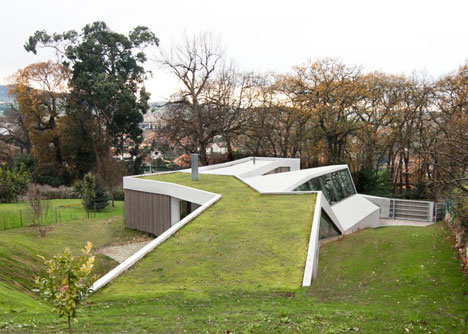As a member of T1 group, in this session, I studied Studio House by F451, and Conditioned Outdoor Room by Bernard Rudofsky. Both of the text and the case are have the thinking of how to deal with the relationship of indoor space and outdoor space, and what can architect do when facing nature.
In the text Conditioned Outdoor Room, the author looked back the changing of American houses since New England settler started to build house in New world. Since the very beginning, human have been fighting to control the climate, but, as the author mentioned, climate cannot be conquered, and we are actually a part of climate. So although we can make our indoor room always comfortable, we still like good climate, good air, and good view, etc. However, American house gardens are not successful in dealing with outdoor and indoor spaces, because although there is big picture window, the garden ends up a decoration of indoor space instead of an outdoor living space. But actually people succeeded in controlling outdoor space. Pompeii house garden is a good example. Those gardens were real outdoor room, they were real living spaces of daily life. The big difference between American garden and Pompeii garden is that Pompeii garden was enclosed by wall, had artificial floor, with an absence of disorder, while American house garden is totally open, more public than private. But if we look into the big difference, it all started from a very simple movement: erecting a wall. The wall makes spaces different, distinguishes in and out, and draws a line between private and public. Also it changes the microclimate around it, provides shadow and shield. This simple movement actually achieved the dream human have for long: control the outdoor climate.
Studio House is also an interesting case. In this case, the architect tries to be in harmony with nature. The atelier has natural light form north, the green roof makes the building part of landscape. Also, from the entrance of the territory, people have to walk in the garden in order to get to house door. Besides, clear big windows also provide good view of garden from indoor room. Here, the house has a good interaction with the nature.
For me, these reading make me think again what we can do as an architect. It’s been a time that people think architect has the power and chance to change something, architect can do something great, like a skyscraper, a monument, even the Radiant City, in order to change society and the world. But now, actually, I started to think in a different way. Space, volume, form and order is till important, but if we want something new, we should look deep into relationship. The world is dynamic, nothing is isolated in vacuum, and everything is related with something else. According to my understanding, advanced architecture is no longer game with spaces, but reflection of different relationship. So, actually, a simple and small movement can do something, like a wall, a hole on the wall to let a branch go though, architecture doesn’t need to be always big.
I’m always interested in understanding our era, the era of information, so I’m really curious about what architecture, even city, would be like in this background. I would like to explore how architecture will interact wig information. As professor mentioned in lecture, architecture is always static, architecture is always build to stand for long. But information is dynamic, it keeps changing and has no shape. To me, the idea of studying how architecture interact with tree is interesting, for a tree keeps changing, although comparatively changing slowly. A tree can make architecture very different, when take into the consideration how to interact with the tree, so it is even more exciting to imaging when architecture interact with information, which is more dynamic, changing much faster. A tree let architecture have expression in time dimension, imaging where information can lead architecture go? It is a really interesting and exciting topic to me. Of course it is more complex than thinking about trees, but studying tree and architecture is a very good hint of how to study the relationship between architecture and information. So, maybe the first thing for me to do, is to understand “information” better.
picture: @dezeen http://static.dezeen.com/uploads/2013/02/dezeen_House-and-Atelier-for-Lara-Rios-by-F451-Arquitectura_4.jpg

